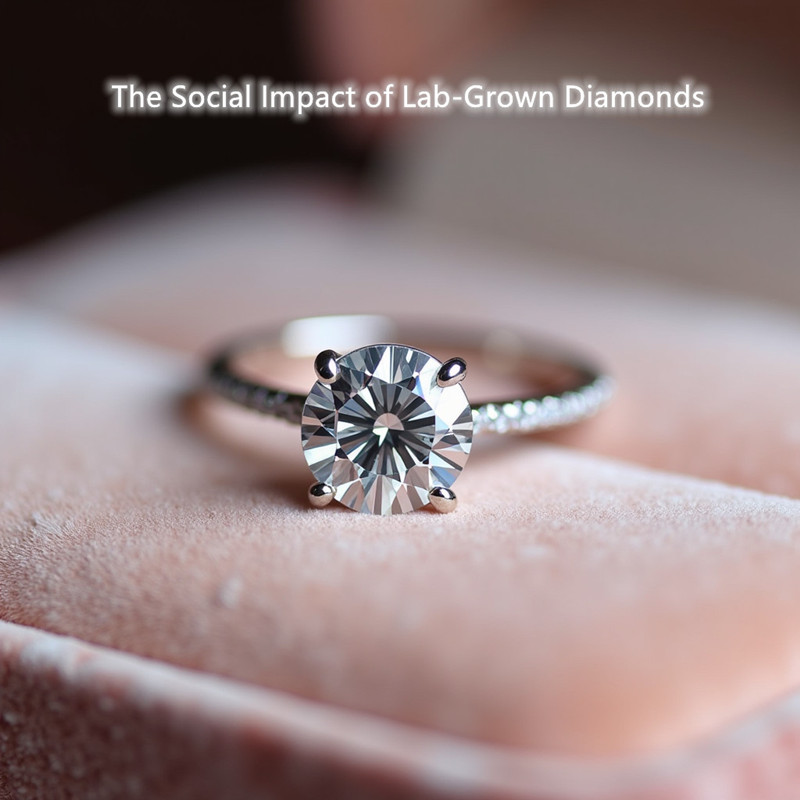
The Social Impact of Lab-Grown Diamonds: Consumer Psychology and Cultural Shifts
Lab-grown diamonds, often touted as an eco-friendly and ethically responsible alternative to mined diamonds, have been carving a significant niche in the jewelry market. Their rise is not merely a trend; it reflects deeper societal changes in consumer psychology and cultural values surrounding love, commitment, and sustainability. This article will explore the acceptance of lab-grown diamonds among consumers, how this acceptance has transformed the jewelry market and wedding culture, and the varied symbolic meanings and acceptance of these gems across different cultures.
Consumer Acceptance of Lab-Grown Diamonds
The Shift in Consumer Behavior
The acceptance of lab-grown diamonds has seen a remarkable transformation over the past decade. Initially, consumers harbored skepticism towards these synthetic alternatives, often associating them with inferior quality or lack of sentimental value. However, as awareness of ethical and environmental concerns related to mining has grown, so too has the willingness of consumers to embrace lab-grown diamonds. Surveys show that a significant percentage of millennials and Generation Z consumers are more inclined to purchase lab-grown diamonds due to their lower price points and ethical implications.
1. The Value of Transparency
One of the primary drivers of consumer acceptance is the increasing demand for transparency in the jewelry industry. Traditional diamond mining practices have often been associated with human rights violations and environmental degradation, which have made consumers more discerning about their purchases. Lab-grown diamonds offer an honest narrative: they are created in controlled environments, minimizing the risk of unethical practices. This transparency resonates with a modern consumer base that values authenticity and ethical sourcing over traditional luxury.
2. The Economic Factor
Economic considerations also play a crucial role in the acceptance of lab-grown diamonds. Typically, lab-grown diamonds are priced lower than their mined counterparts, making them more accessible to a broader audience. In a time when many young couples are burdened by student loans and the high cost of living, the affordability of lab-grown diamonds is a significant selling point. Furthermore, as consumers become more economically conscious, the practicality of purchasing a lab-grown diamond becomes a pragmatic choice, fostering greater acceptance.
3. Changing Attitudes Toward Luxury
Changing perceptions of what constitutes luxury also contribute to the acceptance of lab-grown diamonds. The millennial and Gen Z generations are re-defining luxury not merely in terms of price or brand, but through the lens of sustainability, responsibility, and personal values. A diamond that is grown in a lab, symbolizing ethical practices and minimal environmental impact, aligns with their values far more than a mined diamond tainted by the consequences of mining. Consumers today are looking for products that tell a story, and lab-grown diamonds, with their narratives of sustainability and innovation, are increasingly attractive.
Impact on the Jewelry Market
1. Industry Response
The jewelry industry is responding to the growing acceptance of lab-grown diamonds. Major brands are expanding their offerings to include lab-grown options, while new retailers focusing solely on lab-grown diamonds are emerging. Traditional jewelers are adapting their marketing strategies to appeal to a more ethically-minded clientele, showcasing the stories behind their lab-grown diamonds and emphasizing their sustainable practices. The competition is intensifying, and retailers that fail to acknowledge this shift may find themselves losing market share.
2. Market Dynamics
The emergence of lab-grown diamonds has altered market dynamics significantly. With lower price points and shifting consumer preferences, mined diamond sales have seen a decline. Some industry experts predict that within a decade, lab-grown diamonds may occupy a significant portion of the market, potentially leading to a re-evaluation of how diamonds are perceived as a luxury item. Consequently, the market could shift toward an equilibrium where lab-grown and mined diamonds coexist, albeit with different consumer bases.

3. Changes in Wedding Culture
As lab-grown diamonds become more accepted, the cultural practices surrounding weddings and engagement are evolving. Couples are increasingly prioritizing ethical considerations when choosing their engagement rings, often viewing lab-grown diamonds as a way to make a statement about their values. This shift is also influencing how weddings are planned and celebrated. Couples may choose to allocate their budgets toward experiences such as travel or home purchases, rather than spending heavily on a single diamond.
Cultural Symbolism and Acceptance of Lab-Grown Diamonds
1. Western Culture
In Western cultures, loose lab diamonds have typically been positioned as modern and innovative. They symbolize a shift towards responsible consumerism, allowing couples to engage in sustainability while making a significant commitment. While mined diamonds still reign in traditional contexts, the acceptance of lab-grown diamonds signifies a progressive shift towards valuing personal ethics over societal expectations.
2. Asian Cultures
The acceptance of lab-grown diamonds in Asian cultures is more varied. In countries like China, where traditional customs play a significant role in engagement and marriage, mined diamonds are often associated with status and social standing. However, there is a growing trend among younger couples who are willing to consider lab-grown options, primarily due to economic factors and the increasing emphasis on sustainability. The symbolic meaning of the diamond as a representation of love and commitment remains intact, regardless of its origin.
3. Middle Eastern Perspectives
In Middle Eastern cultures, where legacy and tradition heavily influence consumer behavior, lab-grown diamonds may face more resistance. However, there is a burgeoning awareness of sustainability issues, allowing for gradual acceptance. The wealthy classes may still prefer mined diamonds for their perceived value, but shifting attitudes among the younger generation indicate a growing willingness to embrace lab-grown alternatives as a way to align with global sustainability movements.
Conclusion
The rise of lab-grown diamonds represents a significant cultural and economic shift in the jewelry market. As consumer acceptance continues to grow, the jewelry industry is being prompted to adapt to new values surrounding ethics, sustainability, and personal expression. In varying cultural contexts, lab-grown diamonds hold unique meanings while challenging traditional notions of luxury and commitment. Ultimately, this evolution reflects a broader societal trend toward conscious consumerism that is reshaping not just the jewelry market but also the cultural practices surrounding love and commitment.
References
[1] Diamond Foundry – What Are Lab Grown Diamonds?
[2] Market Research Future – Lab-Grown Diamonds Market Research Report.
[3] The Knot – Engagement Trends 2021.
[4] Ethical Consumer – The True Cost of Diamonds.











